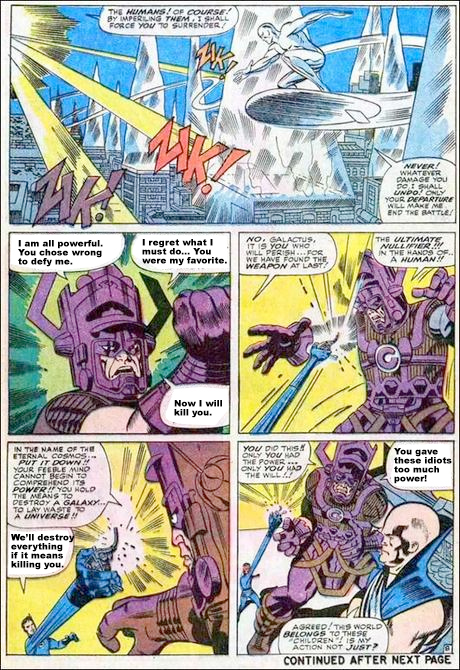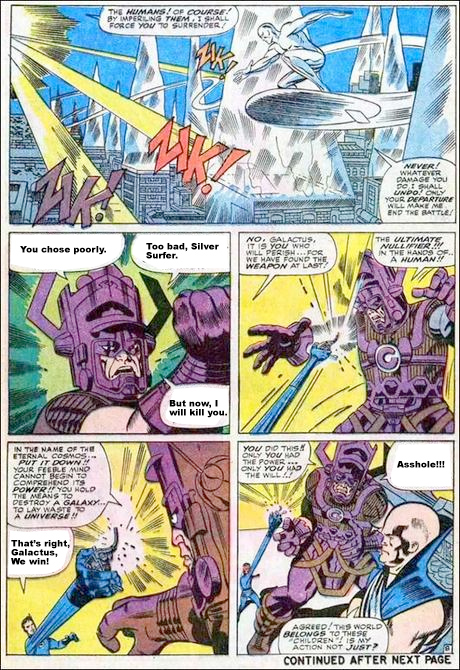I often call people out on writing “On the Nose” dialogue; dialogue without any subtext… dialogue that says exactly what it means.
On the Nose dialogue rarely engages reader and is almost always a clear indicator the writer is losing, or has lost, control of his narrative.
Remember, every detail in a comic is an opportunity to control the narrative; to express the story and control the reader’s experience. When a writer delivers On the Nose dialogue, they squander this opportunity.
When folks write On the Nose, they often deliver a double whammy, by delivering Barren Dialogue at the same time. This is the worst case scenario. Let me show you exactly what I’m talking about, I’ll snatch this interior page of Fantastic Four 50 I found on the interwebs.
Thanks Stan!
Solid Writing
In this first selection, I’ve highlighted the bits with the strongest subtext. If you read this entire page, you’ll see there’s actually a mix of quality to the writing. In other words, some real subtext heavy moments, some actual, on the nose moments, and some in-between.
While on the nose writing is generally bad, when balanced in the context of good writing, it can be fine. This is primarily because comics are such a restrictive medium and we often, simply don’t have the time to make every line a subtextual poetic masterpiece.
I can’t say that this page is perfect, with no room for improvement, but pay attention to how all of it generally works together to push the narrative.
This is most important aspect of writing effective dialogue.
Making every line work for a living.
Notice in Panel 1, in both bubbles we get an introductory on the nose line, followed by a nice subtext filled line. Lee uses this technique to kind of declare what the intent of the overall bubble is, then flower it out with a little purple prose.
I’d say it’s a pretty effective balance in getting more meaning in a smaller package.
If you we look at Panel 3. “The Ultimate Nullifier!! In the hands of a human!!”
This is pretty on the nose, though that last bit makes an implication that lends some weight to the statement… but notice that even on the nose, Mr. Lee, used the moment to get the name of the weapon in there.
Assuming we’ve heard of the weapon before, that on the nose declaration gives immediate context.
Stan could have gone “Barren” and said “That weapon in the hands of humans!!” or something similarly void of any meaning whatsoever.
Bonus:
Check out Stan the Man’s last line on this page. Where subtext adds depth and meaning to a line, gets the reader thinking on it long after they actually finished reading it.
Asking a question amplifies that even further!
I mean think about it, a question is literally challenging the reader to stop, consider and conceive an answer. It’s forcing the reader to dwell on the material.
That’s next level stuff right there.
Of course, the question itself has to be bad-ass. Asking “Do you like pickle juice?” isn’t likely to get much engagement from the reader.
On The Nose Writing
In this version of the same page, I’ve gone in and rewritten the dialogue completely on the nose.
This is the shit you want to avoid.
If you’re paying attention, you may notice this dialogue is the underlying meaning of what Stan says in his proper version above.
That’s the whole point of on the nose dialogue, it hits you at face value. It is what it is, with no interpretation, subtext, or deeper weight behind it.
While you can structure on the nose dialogue to support elements of the narrative; as we saw above, you can use it to push a plot point, like calling out the proper name of something, or writing it in a way that supports character personality… most of the time, on the nose writing reduces to a generic feel.
On the nose writing, is almost like the extras in a movie. They don’t serve a real purpose. Their just stand ins, filler, a means to push the reader from point a to point b… and again, ultimately.
Missed opportunity.
Barren Writing
Now we get to the real core of this article, Barren Writing, or useless, meaningless writing.
Writing that’s on the nose, and has no support for the narrative at all.
I find it actually pretty difficult to write Barren Writing, even for a teaching article. Keep in mind, that Barren Writing isn’t necessarily short writing; though in these examples, most were reduced to very short bits.
Barren writing can certainly span the full length of the dialogues from Stan’s real page… In those instances, writers simply go on about nothing.
Notice, the Barren Writing examples when read alone have no support for the individual speaker, OR context of the narrative… at all.
A couple last things to keep in mind;
Like I said earlier, it’s ok to slip in some on the nose stuff, or even Barren writing, once in a while for effect. The synergy of the page and expression of the narrative is most important.
An on the nose or barren line, can often work in panels of high emotion and/or dramatic climax.
For example, a character who’s lost everything and just broke up with his wife, might turn to the camera and with a tear in his eye, whisper, “I’m sorry.”
But when you do this, make sure that the words themselves are creating the impact you want for the narrative. In other words, you don’t need the support of good dialogue to make your point, it’s literally the words themselves, the diction, that’s doing the work.
No matter what, if you find you’re writing on the nose, with frequency. If most of your panels on the page are on the nose, or barren, for whatever reason.
Stop.
And reassess.
You’re missing opportunity to make your script far more effective! Guaranteed. ▪
About the Author —
Nick Macari is a full-time freelance story consultant, developmental editor and writer, working primarily in the independent gaming and comic markets. His first published comic appeared on shelves via Diamond in the late 90’s. Today you can find his comic work on comixology, amazon and in select stores around the U.S. Visit NickMacari.com for social media contacts and news on his latest releases.



